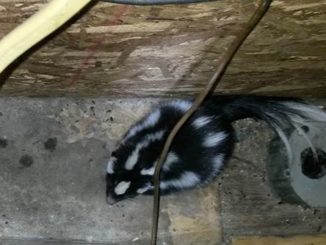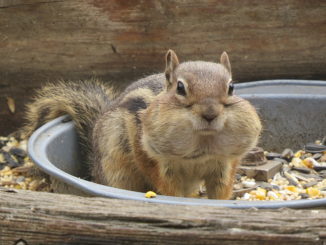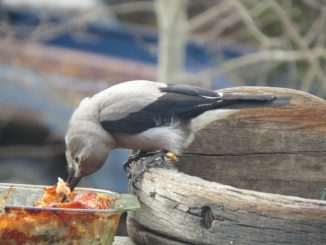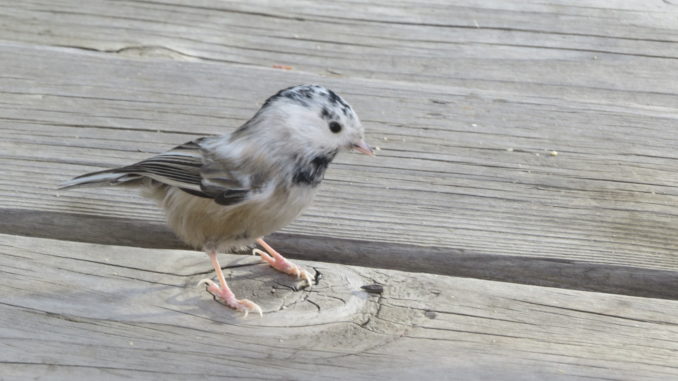
BY SALLY ROTH
North Forty News
Halloween is coming, but my favorite trick-or-treater isn’t interested in candy bars. No Kit Kats, no Reese’s peanut butter cups, not even the mini Snickers I can’t resist.
This little guy wants sunflower seeds.
For years, a single leucistic (partial albino) chickadee has shown up at our feeder around Halloween. The one I’m waiting for is the fifth generation of these mutants, we figure.
The first weirdo took us a while to notice. “Shouldn’t chickadees have black legs?” Indeed, they should. But one of the mountain chickadees at the feeder had pink legs and a pink beak, instead of black. “Pinky,” we immediately dubbed him or her, with our usual sophisticated choice of names.
Pinky stuck around all winter, but left in spring, about the time other chickadees were pairing up.
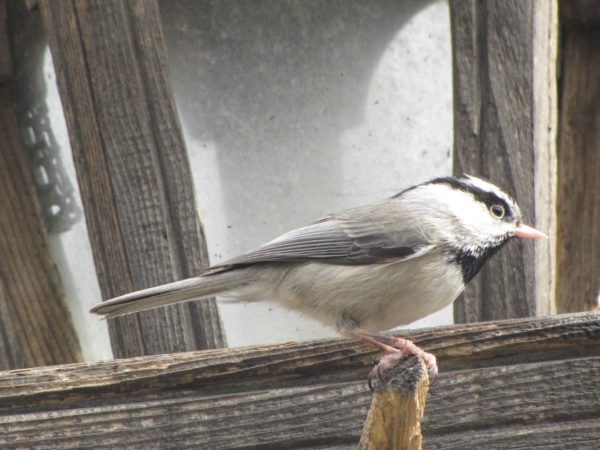
“Aren’t chickadees supposed to have black legs?” The bird we named “Pinky” was the first mutant we noticed.
The following fall, exactly on Halloween, I was basking in Indian summer weather out on the porch when a little white ghost of a bird landed on the rail. It took me a second to recognize it as a chickadee, because this one was much whiter than usual.
That was “Snowflake,” and he had some serious structural problems—his pink toes were partly fused together, although the defect didn’t seem to hinder him, and his body feathers were so long, they looked like fur.
We spent hours trying to figure out whether Snowflake was a mountain or black-capped chickadee, both of which are common here. Finally, it dawned on us: Pinky, who was definitely a mountain chickadee, had exhibited the first signs of a leucistic gene. Snowflake must be that bird’s progeny, and the mutation had become more severe.
Come spring, Snowflake melted away, just as his predecessor Pinky had done.
The next fall—Halloween week again—“Snowflake Junior” arrived. Even whiter than the original Snowflake, and with normal, albeit pink, toes. Like his predecessor, he stuck around all winter and deserted us in spring.
A year later, “Snowflake the Third.” (Or was it the fourth? We were losing track.) This ghostly guy had a two-tone bill, black on top, pink below. Like his forerunners, gone in spring.
Last fall, as Halloween neared… “Oh boy, it’s Snowflake!” By then, we weren’t even trying to give each one a new name.
And this spring, Snowflake didn’t leave! As some chickadees migrated, and others paired up and began raising families, the poor guy hung around all by his lonesome. Then, to our delighted surprise, he found a mate, a normal bird. When we stopped filling the feeder because bears were on the prowl, they moved off. Together.
We caught one quick glimpse of the whole family this summer, moving through the pine forest around our house. Snowflake, who was bringing up the rear, stood out like a spotlight, but we didn’t get a good look at the youngsters.
Now, Halloween is coming, and we’re eagerly awaiting the first Snowflake. Can’t wait to see what sort of costumes his kids will be wearing when they come trick-or-treating. No matter how cute they are, though, they aren’t getting my Snickers.
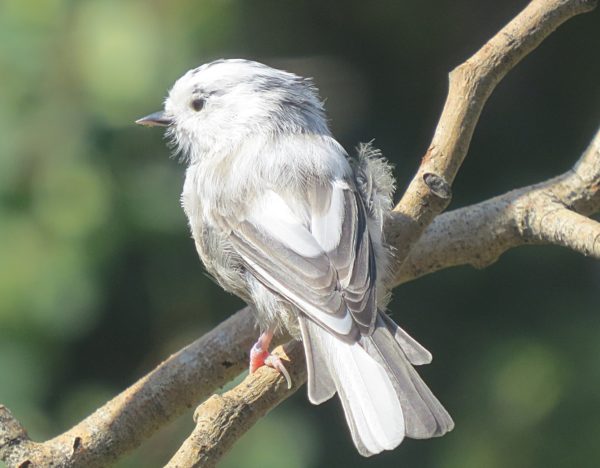
Unlike his predecessors. last October’s “Snowflake” didn’t depart in spring. He paired up with a normal bird here, and raised a family.
Support Northern Colorado Journalism
Show your support for North Forty News by helping us produce more content. It's a kind and simple gesture that will help us continue to bring more content to you.
BONUS - Donors get a link in their receipt to sign up for our once-per-week instant text messaging alert. Get your e-copy of North Forty News the moment it is released!
Click to Donate

